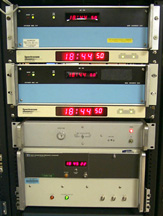|
|

See the radios, all in a row.
Last update:
The NTP Version 4 daemon supports some three dozen different radio, satellite and modem reference clocks plus a special pseudo-clock used for backup or when no other clock source is available. Detailed descriptions of individual device drivers and options can be found in the Reference Clock Drivers page. Additional information can be found in the pages linked there, including the Debugging Hints for Reference Clock Drivers and How To Write a Reference Clock Driver pages. In addition, support for a PPS signal is available as described in Pulse-per-second (PPS) Signal Interfacing page. Many drivers support special line discipline/streams modules which can significantly improve the accuracy using the driver. These are described in the Line Disciplines and Streams Drivers page.
A reference clock will generally (though not always) be a radio timecode receiver which is synchronized to a source of standard time such as the services offered by the NRC in Canada and NIST and USNO in the US. The interface between the computer and the timecode receiver is device dependent, but is usually a serial port. A device driver specific to each reference clock must be selected and compiled in the distribution; however, most common radio, satellite and modem clocks are included by default. Note that an attempt to configure a reference clock when the driver has not been compiled or the hardware port has not been appropriately configured results in a scalding remark to the system log file, but is otherwise non hazardous.
For the purposes of configuration, ntpd treats reference clocks in a manner analogous to normal NTP peers as much as possible. Reference clocks are identified by a syntactically correct but invalid IP address, in order to distinguish them from normal NTP peers. Reference clock addresses are of the form 127.127.t.u, where t is an integer denoting the clock type and u indicates the unit number in the range 0-3. While it may seem overkill, it is in fact sometimes useful to configure multiple reference clocks of the same type, in which case the unit numbers must be unique.
The server command is used to configure a reference clock, where the address argument in that command is the clock address. The key, version and ttl options are not used for reference clock support. The mode option is added for reference clock support, as described below. The prefer option can be useful to persuade the server to cherish a reference clock with somewhat more enthusiasm than other reference clocks or peers. Further information on this option can be found in the Mitigation Rules and the prefer Keyword page. The minpoll and maxpoll options have meaning only for selected clock drivers. See the individual clock driver document pages for additional information.
The fudge command is used to provide additional information for individual clock drivers and normally follows immediately after the server command. The address argument specifies the clock address. The refid and stratum options control can be used to override the defaults for the device. There are two optional device-dependent time offsets and four flags that can be included in the fudge command as well.
The stratum number of a reference clock is by default zero. Since the ntpd daemon adds one to the stratum of each peer, a primary server ordinarily displays an external stratum of one. In order to provide engineered backups, it is often useful to specify the reference clock stratum as greater than zero. The stratum option is used for this purpose. Also, in cases involving both a reference clock and a pulse-per-second (PPS) discipline signal, it is useful to specify the reference clock identifier as other than the default, depending on the driver. The refid option is used for this purpose. Except where noted, these options apply to all clock drivers.